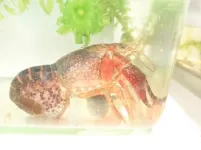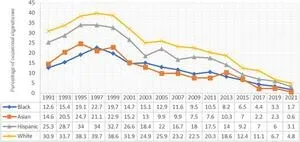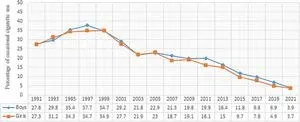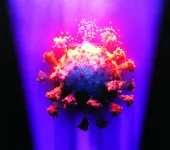(Press-News.org) Procambarus clarkii is a crustacean species native to American freshwater bodies. Brought to Japan in the 1920s as a feed for frogs, this crustacean has slowly taken over the Japanese freshwaters by predation and propagation. In fact, in 2023, the red-swamp crayfish was designated as an invasive alien species by the Japanese Ministry of the Environment and of the Agriculture, Forestry and Fisheries.
One way to control the growth in population of red-swamp crayfish and the accompanying crisis is to capture the red-swamp crayfish in their reproductive form. To this end, however, it is essential to understand their reproductive characteristics, including their anatomical alterations. However, little is known about the reproductive biology of P. clarkii, not only in Japan, but also in their habitats elsewhere around the world. To address this research gap, researchers led by Professor Kazuyoshi Nakata of Okayama University, recently studied several reproduction aspects and morphological characteristics of the red-swamp crayfish. Mr. Quang-Tuong Luong, Ms. Rika Shiraishi, and Dr. Koki R. Katsuhara were also a part of this study, which was published in the Journal of Crustacean Biology on October 31, 2023.
To undertake this study, the researchers first collected the red-swamp crayfish over a span of one year, from November 2015 to November 2016, from a local pond in Okayama, western Japan. They collected and observed a total of 6,319 crayfishes, comprising 2,601 males and 2,777 females, with eight of unknown sex and 933 juveniles.
Red-swamp crayfish have four growth stages—eggs, hatchlings, juveniles, and adults. Adults alternate from being in a sexually active form (Form I) to a sexually inactive form (Form II). In the breeding season that peaks in autumn, it was observed that males in Form I had enlarged chelae, or the claw-shaped structures that crustaceans utilize for defense and capturing prey. By identifying this characteristic, this study is the first to highlight that hook length is an important indicator of sexual status in red-swamp crayfish. Hooks are the sharp horn-like extensions present on the third and fourth feet of the red-swamp crayfish. Most importantly, hooks are used by the males to secure the female in the mating position. It was visibly larger in Form I males than in Form II males. Confirming their observation, Prof. Nakata from the Faculty of Environmental, Life, Natural Science and Technology, Okayama University, Japan says, “Our results indicate that both chelae and hook length in males significantly differed among Form I and Form II, revealing chelae or hook length to be an important identifier for Form I or II males of P. clarkii.”
Moreover, the results also clarified that the invasive red-swamp crayfish P. clarkii shows a high reproductive ability and a fast growth rate compared to the Japanese native crayfish C. japonicus. It was observed that the female red-swamp crayfish could carry as many as 100 to 375 eggs per individual, whereas the Japanese native crayfish could carry only about 18 to 75 eggs. In red-swamp crayfish, even though the optimum temperature for egg hatching was found to be 25 °C, egg hatching could occur at temperatures as low as 7 °C. The cumulative degree for egg-to-juvenile maturation was found to be 1,222 °C.
Explaining these findings, Prof. Nakata says, “From this temperature value, it was possible to estimate the spawning date for juveniles. Moreover, the hatching dates and the time of juveniles leaving the females can also be calculated.” While the native Japanese crayfish takes approximately five years to reach reproductive age, the red-swamp crayfish invasive species reaches this age in the fastest case within just five months of hatching, which explains the fast growth rate of this highly invasive species.
Going ahead, these findings will contribute to promoting effective control of the invasive populations of P. clarkii and aid in the conservation of biodiversity in freshwater areas around the world.
About Okayama University, Japan
As one of the leading universities in Japan, Okayama University aims to create and establish a new paradigm for the sustainable development of the world. Okayama University offers a wide range of academic fields, which become the basis of the integrated graduate schools. This not only allows us to conduct the most advanced and up-to-date research, but also provides an enriching educational experience.
Website: https://www.okayama-u.ac.jp/index_e.html
About Professor Kazuyoshi Nakata from Okayama University, Japan
Dr. Kazuyoshi Nakata is a Professor at the Faculty of Environmental, Life, Natural Science and Technology at Okayama University, Japan. His areas of interest include conservation, ecology, and civil engineering, with a focus on endangered or invasive freshwater animals including fish, crustaceans and frogs etc. With over 70 publications, he has authored books such as ‘Shrimp, Crab, and Crayfish: Conservation and Biology of Freshwater Crustaceans.’ He has also been a contributor to the ‘Okayama Prefecture Red Data Book 2020’ that conducts surveys of animal populations and enlists endangered species. Apart from crustaceans, his research highlights conservation of an endangered bitterling fish Rhodeus atremius suigensis and ecological aspects of the Daruma frog, an endangered species from western Japan. Dr. Nakata was previously associated with Hokkaido University.
END
Unveiling the reproductive secrets of red-swamp crayfish
Findings about their reproductive ability can help mitigate the overpopulation crisis that threatens native species in Japan’s freshwater ecosystems
2024-01-10
ELSE PRESS RELEASES FROM THIS DATE:
US heart disease deaths linked with substance use rose 4% per year between 1999-2019
2024-01-10
Research Highlights:
Despite drops in overall cardiovascular disease deaths from 1999-2019, cardiovascular disease deaths in which substance use was cited as a contributing factor increased an average of 4% per year, with the death rate accelerating to 6.2% from 2012-2019.
Prominent increases in cardiovascular deaths associated with substance use were most notable among women, American Indian or Alaskan individuals, younger individuals, rural area residents and users of cannabis and psychostimulants.
Identifying high-risk groups is crucial for prioritizing preventive measures to reduce substance use linked with cardiovascular disease deaths, particularly ...
Noninvasive technique reveals how cells’ gene expression changes over time
2024-01-10
CAMBRIDGE, MA -- Sequencing all of the RNA in a cell can reveal a great deal of information about that cell’s function and what it is doing at a given point in time. However, the sequencing process destroys the cell, making it difficult to study ongoing changes in gene expression.
An alternative approach developed at MIT could enable researchers to track such changes over extended periods of time. The new method, which is based on a noninvasive imaging technique known as Raman spectroscopy, doesn’t harm cells and can be performed repeatedly.
Using ...
Rice scientists use blood test to track gene expression in the brain
2024-01-10
HOUSTON – (Jan. 10, 2023) – The brain is the most protected organ in the body, sheathed in a complex and nearly impenetrable barrier of specialized blood vessels. While this particular anatomical setup protects it from outside invaders, it also makes it difficult for researchers to study how specific genes are expressed ⎯ and how such changes in gene expression may lead to disease.
Now Rice University scientists have developed a noninvasive way to monitor gene expression dynamics in the brain, making it easier to investigate brain ...
Unravelling individual differences in DNA mutation risks
2024-01-10
Barcelona, 10 January 2024 – Mutations, which occur continuously in every cell of our bodies, are a key contributor to cancer, ageing, and neurodegeneration. While exposure to mutagenic chemicals, or mistakes in cellular processes during DNA replication contribute to these mutations, the exact distribution and patterns of these changes across human chromosomes have remained a mystery until now.
Dr. Fran Supek, ICREA researcher and head of the Genome Data Science lab at IRB Barcelona, and Marina Salvadores, PhD student ...
Scientists discover how ultraviolet light degrades coronavirus
2024-01-10
New research has revealed how light can be used to destroy infectious coronavirus particles that contaminate surfaces. Scientists are interested in how environments, such as surgeries, can be thoroughly disinfected from viruses such as SARS-CoV-2 that caused the COVID-19 pandemic.
SARS-CoV-2 viral particles are composed of a core of nucleic acid chains that contain the genetic information of the virus, surrounded by a lipid membrane with proteinous spikes sticking out. Each component is necessary for infection.
Researchers from the University of Southampton investigated how ultraviolet laser light destroys the virus by impacting each of these critical components. By using a specialised ...
Tackling the effect of climate change on diarrheal diseases
2024-01-10
Diarrhoea is, globally, the second largest cause of death for children under 5. Contributing to more than 500,000 deaths, only pneumonia kills more children each year. Climate change, driving increased flooding and droughts, threatens the fragile progress made in reducing the burden of diarrheal disease over the past decades. Together with the Amsterdam Institute of Global Health and Development, Amsterdam UMC is set to lead a global consortium in the hunt for improved interventions.
"We see that the impact of climate change on diseases transmission depends on the constantly changing interaction between climate events, local ...
Do symptoms of post-traumatic stress disorder facilitate substance use as a coping method among children after a natural disaster?
2024-01-10
In a survey-based study of 3rd to 12th grade students in Puerto Rico after 2017’s Hurricane Maria, certain symptoms of post-traumatic stress disorder (PTSD) were linked with a higher risk of using drugs or alcohol.
The study, which is published in the Journal of Traumatic Stress, included 91,732 youths who completed a survey 5–9 months after Hurricane Maria made landfall in Puerto Rico. Associations between PTSD symptoms and substance use were examined using a network conceptualization, which views disorders as stemming from interactions ...
Microplastics affect soil fungi depending on drought conditions
2024-01-10
Moisture levels in the soil can impact the effects that microplastic pollution has on soil fungi, according to new research published in Environmental Microbiology.
By studying soil samples mixed with microplastics under different conditions, investigators found that when soil is well-watered, toxic chemicals in microplastics can leach into the soil and hinder soil fungal richness. With dry soil, however, the leaching of water-extractable chemicals is less pronounced and therefore less impactful on soil fungal structure.
The researchers also noted that under dry conditions, microplastics help soil hold water for longer, which could help ...
Is a commonly used screening tool for cognitive impairment accurate in diverse populations?
2024-01-10
A screening tool often used in primary care clinics to detect cognitive impairment has shortcomings when applied to ethnically and linguistically diverse older adults, according to a study published in the Journal of the American Geriatrics Society.
The study looked to see whether currently published English and Spanish cut points for cognitive impairment in the Montreal Cognitive Assessment (MoCA) are appropriate in diverse community-based adults aged 65 years or older with cognitive concerns in the Bronx, New York. There were 231 participants (43% ...
Do individual-level mental health interventions improve employees’ wellbeing?
2024-01-10
Many businesses are making efforts to promote workers’ wellbeing, and numerous interventions are available at the individual and organizational levels. New research published in the Industrial Relations Journal found no evidence that individual-level mental wellbeing interventions like mindfulness, resilience and stress management, relaxation classes, and wellbeing apps benefit employees.
The study was based on survey data from 46,336 workers in 233 organizations in the UK. Across multiple subjective wellbeing indicators, participants in individual-level mental wellbeing interventions appeared no better off than other workers.
The study’s ...
LAST 30 PRESS RELEASES:
New study reveals major gaps in global forest maps
Ochsner Health names Dr. Timothy Riddell executive vice president and chief operating officer
Can future-focused thoughts help smokers quit?
From brain scans to alloys: Teaching AI to make sense of complex research data
Stem Cell Reports seeks early career editors to join the editorial board
Signs of ancient life turn up in an unexpected place
Pennington Biomedical researchers explore factors behind body’s ability to regulate weight
Zhongping Lee awarded the Nils Gunnar Jerlov Medal
Deborah S. Kelley awarded the Wallace S. Broecker Medal
Novel immunotherapy demonstrates early potential to overcome resistance to immune checkpoint therapy
LLM treatment advice agrees with physician recommendations in early-stage HCC, but falls short in late stage
Deep learning model trained with stage II colorectal cancer whole slide images identifies features associated with risk of recurrence – with higher success rate than clinical prognostic parameters
Aboard the International Space Station, viruses and bacteria show atypical interplay
Therapies that target specific type of cell death may be an effective avenue for cancer treatment, UTHealth Houston researchers find
CHEST releases guideline on biologic management in severe asthma
Scientists create a system for tracking underwater blackouts
Fruit fly pigmentation guides discovery of genes that control brain dopamine and sleep
World's largest physics conference to be held in Denver and online this March
New mega-analysis reveals why memory declines with age
Understanding ammonia energy’s tradeoffs around the world
UTHealth Houston researchers map gene disruptions in sporadic early onset Alzheimer’s disease across key brain regions
Minimum wage increases are linked to safer pregnancies
Left in the cold: Study finds most renters shut out of energy-saving upgrades
This crystal sings back: Illinois collaboration sheds light on magnetochiral instability
Organisms in the Atacama Desert soil are remarkably diverse
Children’s Hospital Colorado research outlines first pediatric classifications for suicide risk in adolescents and kids
No thyme wasted: Harnessing the medicinal benefits of thyme extract With small doses
Fat surrounding the colon interacts with the immune system
Genetic predisposition to excess body weight and survival in women diagnosed with breast cancer
New mechanism links Epstein-Barr virus to MS
[Press-News.org] Unveiling the reproductive secrets of red-swamp crayfishFindings about their reproductive ability can help mitigate the overpopulation crisis that threatens native species in Japan’s freshwater ecosystems




